Advertisements
Advertisements
Question
Describe one experiment you would perform to demonstrate the following phenomena: The germinating seeds to give out carbon dioxide.
Solution
(1) Take two flasks 'A' and' B'.
(2) Place some wet cotton wool at the bottom of both the flasks.
(3) Place some soaked seeds of pea in flask A and an equal number of boiled or dead seeds in flask B. Add some carbolic acid to flask B to prevent the growth of bacteria on dead seeds.
(4) Cork the flasks and keep them undisturbed for few days.
(5) After few days, the seeds in flask A will have germinated and the seeds in flask B do not show any signs of germination.
(6) The gases in each of the flasks are then tested by removing the cork and tilting the flask over a test tube containing limewater and then shaking up the test tube.
(7) The expected CO2 present in flask A will turn limewater milky showing that germinating seeds give out CO2, while the gas in flask B will show no effect on limewater.
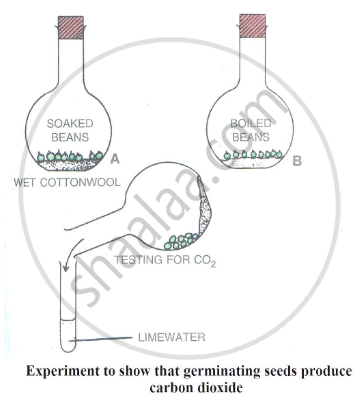
APPEARS IN
RELATED QUESTIONS
The following diagram refers to an apparatus which is used to demonstrate a physiological process:

What is the purpose of keeping potassium hydroxide solution in test tubes X and Y?
The following diagram refers to an apparatus which is used to demonstrate a physiological process:

Why has the coloured water risen in tubing 1?
Given below is a set of six experimental set-ups (A-F), kept in this state for about 24 hours.
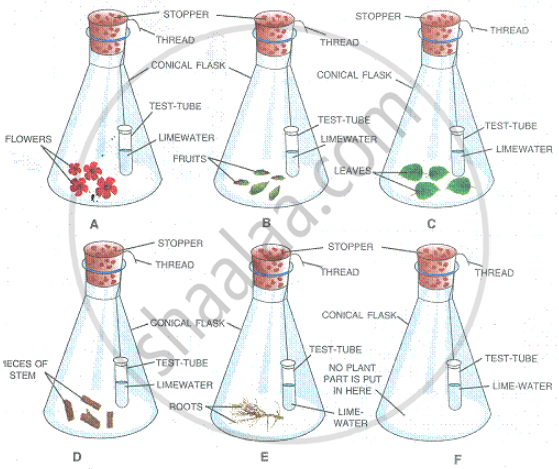
What is the purpose of keeping a test-tube containing limewater in each flask?
In order to study and prove a particular physiological process in plants, the following experiment was set up. Study the same and then answer the question that follows:
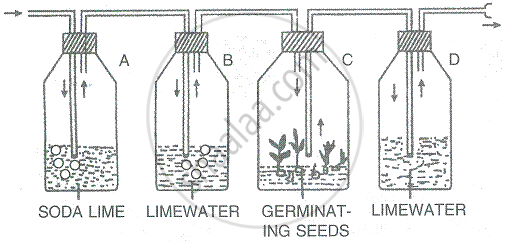
Name the physiological process being studied.
In order to study and prove a particular physiological process in plants, the following experiment was set up. Study the same and then answer the question that follows:

What is the function of soda lime in the bottle 'A' and why is limewater placed in bottle 'B'?
In order to study and prove a particular physiological process in plants, the following experiment was set up. Study the same and then answer the question that follow:

What change would you expect to observe in bottle 'D'?
In order to study and prove a particular physiological process in plants, the following experiment was set up. Study the same and then answer the question that follow:
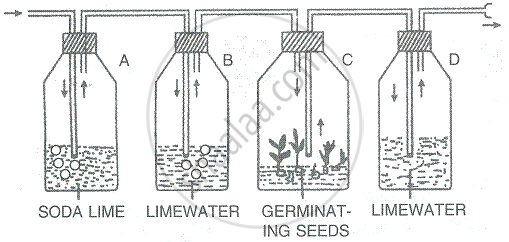
Represent the physiological process named in question 4.1 in the form of a chemical equation.
Given alongside is an experimental set up to demonstrate a phenomenon in a plant:
(a) What is the aim of this experiment?
(b) Why was the bell jar covered with a black cloth?
(c) What is the function of caustic soda in this experiment?
(d) Give an overall chemical equation of the process mentioned in (a) above.
(e) Mention one precaution that should be taken to ensure more accurate results. What change, if any, would you observe in the lime water in Flask A and B? In each case give a reason for your answer.

The given fig. refers to an apparatus which is used to demonstrate a physiological process:
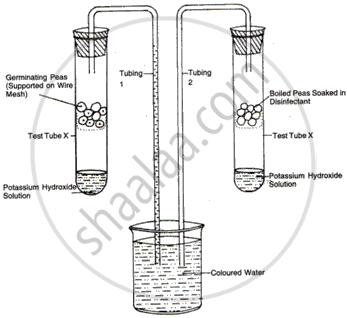
(a) What is the purpose of keeping potassium hydroxide solution in test tubes X and Y?
(b) What is the purpose of keeping boiled peas soaked in disinfectant in test tube Y?
(c) Why has coloured water risen in tube 1?
(d) Name the biological process which causes the above rise.
(e) Define the biological process shown in the experiment.
Name the following:
The chemicals generally used to absorb carbon dioxide in respiratory experiments.
